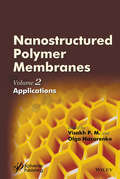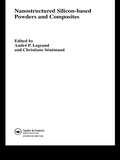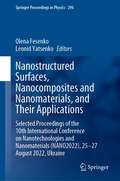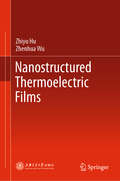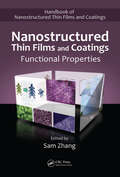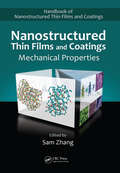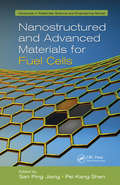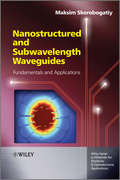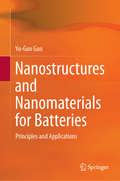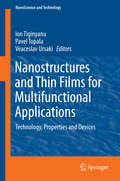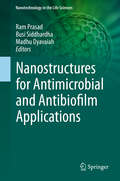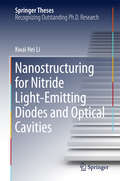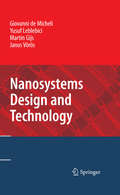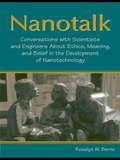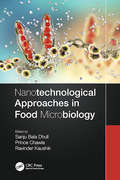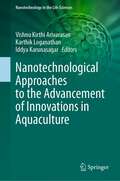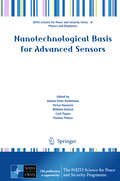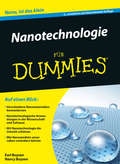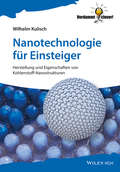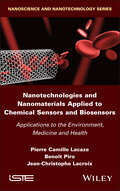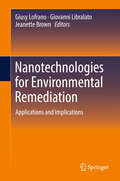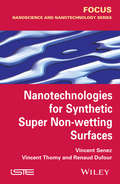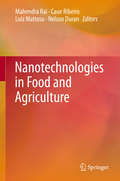- Table View
- List View
Nanostructured Polymer Membranes: Applications
by Visakh P. M. Olga NazarenkoThe 2nd volume on applications with discuss the various aspects of state-of-the-art, new challenges and opportunities for gas and vapor separation of polymer membranes, membranes for wastewater treatment, polymer electrolyte membranes and methanol fuel cells, polymer membranes for water desalination, optical, electrochemical and anion/polyanion sensors, polymeric pervaporation membranes, organic-organic separation, biopolymer electrolytes for energy devices, carbon nanoparticles for pervaporation polymeric membranes, and mixed matrix membranes for nanofiltration application.
Nanostructured Polymer Membranes: Processing and Characterization
by Visakh P. M. Olga NazarenkoThis book is intended to serve as a “one-stop” reference resource for important research accomplishments in the area of nanostructured polymer membranes and their processing and characterizations. It will be a very valuable reference source for university and college faculties, professionals, post-doctoral research fellows, senior graduate students, and researchers from R&D laboratories working in the area of polymer nanobased membranes.
Nanostructured Silicon-based Powders and Composites
by André P. Legrand Christiane SénémaudIn recent years an increasing interest has been devoted to nanostructured composites. This attention is largely due to exciting possible applications ranging from new catalysts to the preparation of nanocomposites ceramics, with significant improvements in their properties. This book provides a comprehensive survey of French contributions t
Nanostructured Surfaces, Nanocomposites and Nanomaterials, and Their Applications: Selected Proceedings of the 10th International Conference on Nanotechnologies and Nanomaterials (NANO2022), 25—27 August 2022, Ukraine (Springer Proceedings in Physics #296)
by Leonid Yatsenko Olena FesenkoThis book highlights some of the latest advances in nanotechnology and nanomaterials from leading researchers in Ukraine, Europe and beyond. It features contributions presented at the 10th International Science and Practice Conference Nanotechnology and Nanomaterials (NANO2022), which was held in hybrid format on August 25-27, 2022 at Lviv House of Scientists, and was jointly organized by the Institute of Physics of the National Academy of Sciences of Ukraine, University of Tartu (Estonia), University of Turin (Italy), and Pierre and Marie Curie University (France). Internationally recognized experts from a wide range of universities and research institutions share their knowledge and key findings on material properties, behavior, synthesis and their applications.The book will be interesting for leading scientists, advanced undergraduate and graduate students in material and nanoscience. This book’s companion volume also addresses topics such as nano-optics, nanoelectronics, energy storage, nanochemistryl and biomedical applications.
Nanostructured Thermoelectric Films
by Zhiyu Hu Zhenhua WuThis book presents a range of low-dimensional superlattice thermoelectric materials based on physical vapor deposition (PVD) methods and explores various material types, thicknesses, and processing conditions. With the advances made in the performance of semiconductor thermoelectric materials and the efficiency of thermoelectric devices in recent years, thermoelectric power generation systems are likely to replace traditional mechanical heat engines, offering an environmentally friendlier alternative. The use of low-dimensional, nanostructured materials can significantly increase the density of states near the Fermi level and greatly improve the thermoelectric properties of materials. In addition, the book demonstrates that it is possible to influence thermoelectric performance, establish more accurate mathematical models through the regulation of relevant parameters, and ultimately improve the thermoelectric figure of merit (ZT).
Nanostructured Thin Films and Coatings: Functional Properties
by Sam ZhangAuthored by leading experts from around the world, the three-volume Handbook of Nanostructured Thin Films and Coatings gives scientific researchers and product engineers a resource as dynamic and flexible as the field itself. The first two volumes cover the latest research and application of the mechanical and functional properties of thin films an
Nanostructured Thin Films and Coatings: Mechanical Properties
by Sam ZhangAuthored by leading experts from around the world, the three-volume Handbook of Nanostructured Thin Films and Coatings gives scientific researchers and product engineers a resource as dynamic and flexible as the field itself. The first two volumes cover the latest research and application of the mechanical and functional properties of thin films an
Nanostructured and Advanced Materials for Fuel Cells (Advances in Materials Science and Engineering)
by San Ping Jiang Pei Kang ShenBoasting chapters written by leading international experts, Nanostructured and Advanced Materials for Fuel Cells provides an overview of the progress that has been made so far in the material and catalyst development for fuel cells. The book covers the most recent developments detailing all aspects of synthesis, characterization, and performance.It
Nanostructured and Subwavelength Waveguides
by Maksim SkorobogatiyOptical waveguides take a prominent role in photonics because they are able to trap and to transport light efficiently between a point of excitation and a point of detection. Moreover, waveguides allow the management of many of the fundamental properties of light and allow highly controlled interaction with other optical systems. For this reason waveguides are ubiquitous in telecommunications, sensing, spectroscopy, light sources, and high power light delivery. Nanostructured and subwavelength waveguides have additional advantages; they are able to confine light at a length scale below the diffraction limit and enhance or suppress light-matter interaction, as well as manage fundamental properties of light such as speed and direction of energy and phase propagation.This book presents semi-analytical theory and practical applications of a large number of subwavelength and nanostructured optical waveguides and fibers operating in various regions of the electromagnetic spectrum including visible, near and mid-IR and THz. A large number of approximate, while highly precise analytical expressions are derived that describe various modal properties of the planar and circular isotropic, anisotropic, and metamaterial waveguides and fibers, as well as surface waves propagating on planar, and circular interfaces. A variety of naturally occurring and artificial materials are also considered such as dielectrics, metals, polar materials, anisotropic all-dielectric and metal-dielectric metamaterials.Contents are organized around four major themes:Guidance properties of subwavelength waveguides and fibers made of homogeneous, generally anisotropic materials Guidance properties of nanostructured waveguides and fibers using both exact geometry modelling and effective medium approximationDevelopment of the effective medium approximations for various 1D and 2D nanostructured materials and extension of these approximations to shorter wavelengthsPractical applications of subwavelength and nanostructured waveguides and fibers Nanostructured Subwavelengths and Waveguides is unique in that it collects in a single place an extensive range of analytical solutions which are derived in various limits for many practically important and popular waveguide and fiber geometries and materials.
Nanostructures and Nanomaterials for Batteries: Principles and Applications
by Yu-Guo GuoThis book discusses the roles of nanostructures and nanomaterials in the development of battery materials for state-of-the-art electrochemical energy storage systems, and provides detailed insights into the fundamentals of why batteries need nanostructures and nanomaterials. It explores the advantages offered by nanostructure electrode materials, the challenges of using nanostructured materials in batteries, as well as the rational design of nanostructures and nanomaterials to achieve optimal battery performance. Further, it closely examines the latest advances in the application of nanostructures and nanomaterials for future rechargeable batteries, including high-energy and high-power lithium ion batteries, lithium metal batteries (Li-O2, Li-S, Li-Se, etc.), all-solid-state batteries, and other metal batteries (Na, Mg, Al, etc.). It is a valuable reference resource for readers interested in or involved in research on energy storage, energy materials, electrochemistry and nanotechnology.
Nanostructures and Nanotechnology
by Douglas NatelsonFocusing on the fundamental principles of nanoscience and nanotechnology, this carefully developed textbook will equip students with a deep understanding of the nanoscale. • Each new topic is introduced with a concise summary of the relevant physical principles, emphasising universal commonalities between seemingly disparate areas, and encouraging students to develop an intuitive understanding of this diverse area of study • Accessible introductions to condensed matter physics and materials systems provide students from a broad range of scientific disciplines with all the necessary background • Theoretical concepts are linked to real-world applications, allowing students to connect theory and practice • Chapters are packed with problems to help students develop and retain their understanding, as well as engaging colour illustrations, and are accompanied by suggestions for additional reading. Containing enough material for a one- or two-semester course, this is an excellent resource for senior undergraduate and graduate students with backgrounds in physics, chemistry, materials science and electrical engineering.
Nanostructures and Thin Films for Multifunctional Applications
by Ion Tiginyanu Veaceslav Ursaki Pavel TopalaThis book is focused on recent advances in the development of thin films for photovoltaic applications, TiO2/WO3 bi-layers for applications with enhanced photo-catalytic properties, nanometer oxide and hydroxide films for anticorrosive coatings, surface passivation in chemical industries, micro- and nanoelectronics, trilayers of metglas and lead free piezoelectrics for magnetic field sensors, current sensors, spintronics, microwave and read/write devices. Diluted ferromagnetic alloy films are also considered for superconducting spintronics based on superconducting spin-valves. Thermal properties of segmented nanowires are analyzed with respect to thermoelectric applications. Recent advances in template production of nanocomposites are also reviewed with particular focus on technologies for template assisted formation of metal nanotubes. Some elements related to abrasive flow machining (AFM), specifically state of the art elements of technological systems and construction of equipment are presented. The book is written for researchers in materials science, nanotechnologies, PhD students and graduate student.
Nanostructures for Antimicrobial and Antibiofilm Applications (Nanotechnology in the Life Sciences)
by Ram Prasad Busi Siddhardha Madhu DyavaiahIn the pursuit of technological advancement in the field of biotechnology and pharmaceutical industries to counteract health issues, bacterial infections remain a major cause of morbidity and mortality. The ability of bacterial pathogens to form biofilms further agglomerates the situation by showing resistance to conventional antibiotics. To overcome this serious issue, bioactive metabolites and other natural products were exploited to combat bacterial infections and biofilm-related health consequences. Natural products exhibited promising results in vitro, however; their efficacy in in vivo conditions remain obscured due to their low-solubility, bioavailability, and biocompatibility issues. In this scenario, nanotechnological interventions provide a multifaceted platform for targeted delivery of bioactive compounds by slow and sustained release of drug-like compounds. The unique physico-chemical properties, biocompatibility and eco-friendly nature of bioinspired nanostructures has revolutionized the field of biology to eradicate microbial infections and biofilm-related complications. The green-nanotechnology based metal and metal oxide nanoparticles and polymeric nanoparticles have been regularly employed for antimicrobial and antibiofilm applications without causing damage to host tissues. The implications of these nanoparticles toward achieving sustainability in agriculture by providing systemic resistance against a variety of phytopathogens therefore plays crucial role in growth and crop productivity. Also the advent of smart and hybrid nanomaterials such as metal-based polymer nanocomposites, lipid-based nanomaterials and liposomes have the inherent potential to eradicate bacterial biofilm-related infections in an efficient manner. The recent development of carbon-based nanomaterials such as carbon nanotubes (CNTs) and silica based nanomaterials such as mesoporous silica nanoparticles (MSNs) also exploit a target of dreadful healthcare conditions such as cancer, immunomodulatory diseases, and microbial infections, as well as biofilm-related issues owing to their stability profile, biocompatibility, and unique physio-chemical properties. Recently novel physical approaches such as photothermal therapy (PTT) and antimicrobial photodynamic therapy (aPDT) also revolutionized conventional strategies and are engaged in eradicating microbial biofilm-related infections and related health consequences. These promising advancements in the development of novel strategies to treat microbial infections and biofilm-related multidrug resistance (MDR) phenomenon may provide new avenues and aid to conventional antimicrobial therapeutics.
Nanostructuring for Nitride Light-Emitting Diodes and Optical Cavities
by Kwai Hei LiThis book describes the design and fabrication of novel nanostructures in III-nitride material systems. It introduces an inexpensive and ultra-efficient nanopatterning method - nanosphere lithography (NSL) - used to develop diversely functional nanostructures, including clover-shaped photonic crystals, nanorings, and nanolenses. Furthermore, the research findings previously distributed in various international scientific journals and conference papers are brought together and methodically presented in a unified form. The book is of interest to postgraduate students, university researchers, R&D engineers and scientists in the fields of nanoelectronics, optoelectronics and photonics.
Nanosystems Design and Technology
by Martin Gijs Giovanni Demicheli Yusuf Leblebici Janos VörösNanosystems use new, nanoscopic electrical and/or mechanical devices which, as constituents of electronic and electromechanical systems, find application primarily in computing, embedded control and biomedical data acquisition. In particular, this book will deal with the characterization and patterning of these materials from an engineering perspective, with the objective of creating operational prototypes and products. The book will integrate various nano technologies on materials, devices and systems and identify key areas and results. The book will describe different design aspects for integrated systems on silicon, as well as on heterogeneous platforms including, but not limited to, electrical, optical, micromechanical and biological components in various forms and mixtures. By associating research topics from differing horizons, the book will provide a unique opportunity to bridge the gap between electronics/electrical engineering and materials science. The book will include topics at the intersection of these disciplines, and will interface with computer science, biology and medicine.
Nanotalk: Conversations With Scientists and Engineers About Ethics, Meaning, and Belief in the Development of Nanotechnology
by Rosalyn W. BerneNo one really knows where nanotechnology is leading, what its pursuit will mean, and how it may affect human and other forms of life. Nevertheless, its research and development are moving briskly into that unknown. Nanotalk is a book of conversations and explorations with thirty five such nano-research scientists and engineers who share their ideas
Nanotechnological Approaches in Food Microbiology
by Sanju Bala Dhull Prince Chawla Ravinder KaushikNanotechnology has gained attention in all aspects of modern science, having vital applications in the food chain, storage, quality monitoring, processing, preservation, and packaging. The global population is increasing rapidly, therefore there is a requirement to produce food products in a more proficient, non-toxic, and sustainable way. Food scientists and microbiologists are interested in food safety and quality assurance to produce excellent-quality food free of food pathogens Nanotechnological Approaches in Food Microbiology provides a systematic introduction and comprehensive information about practical approaches and characteristic features related to the significant applications of nanotechnology in food microbiology, including, nano-starch films, nanoemulsions, biogenic nanoparticles, and nanocapsules. The book will explore details about metal nanoparticle synthesis, characterization, mathematical modeling, kinetic studies, and their antimicrobial approaches. Key Features: Includes comprehensive knowledge on metal nanoparticle synthesis, characterization, mathematical modeling, kinetic studies and their antimicrobial approaches Lays out concepts of essential oil nanoemulsion and their potential antimicrobial applications Deals with the latest development in nano-starch composite biofilms containing bioactive constituents to inhibit pathogenic microbes Explores the nanocapsules as potential antimicrobial agents in food. Provides information regarding new biogenic nano-antimicrobials developed for the food safety and quality assurance This book will educate readers on the aspects of nanotechnology in food safety and quality assurance. Nanoemulsions, nanohydrogels, metal nanoparticles, nano-starch films, nanocapsules and nano-antimicrobials are the emerging essentials of nanotechnology that are used to preserve the food at greater extent. This book should be of interest to a large and varied audience of researchers in academia, industry, food processing, preservation, packaging, microbiology and policy regulations.
Nanotechnological Approaches to the Advancement of Innovations in Aquaculture (Nanotechnology in the Life Sciences)
by Vishnu Kirthi Arivarasan Karthik Loganathan Iddya KarunasagarThe main practical breakthrough of this century is nanobiotechnology, an amalgamation of biology and nanotechnology based on the standards and methods of metabolism. The field mainly involves the analysis, synthesis and the links between molecular biology, nutritional science and nanotechnology. In addition, the field involves the links between other life sciences branches, since the improvement of nanotechnology strategies might be directed by considering the structure and the capability of nanoparticles present in the living cells. This book is a comprehensive evaluation of the latest nanobiotechnological developments, with an emphasis on applications, especially in aquaculture. It outlines, in-depth, modern techniques, and includes a variety of important sources that make this the perfect resource for researchers in this captivating world of nanobiotechnology.
Nanotechnological Basis for Advanced Sensors
by Wilhelm Kulisch Cyril Popov Johann Peter Reithmaier Perica Paunovic Plamen PetkovBringing together experts from 15 countries, this book is based on the lectures and contributions of the NATO Advanced Study Institute on "Nanotechnological Basis for Advanced Sensors" held in Sozopol, Bulgaria, 30 May - 11 June, 2010. It gives a broad overview on this topic, and includes articles on: techniques for preparation and characterization of sensor materials; different types of nanoscaled materials for sensor applications, addressing both their structure (nanoparticles, nanocomposites, nanostructured films, etc.) and chemical nature (carbon-based, oxides, glasses, etc.); and on advanced sensors that exploit nanoscience and nanotechnology. In addition, the volume represents an interdisciplinary approach with authors coming from diverse fields such as physics, chemistry, engineering, materials science and biology. A particular strength of the book is its combination of longer papers, introducing the basic knowledge on a certain topic, and brief contributions highlighting special types of sensors and sensor materials.
Nanotechnologie für Dummies (Für Dummies)
by Earl Boysen Richard D. BookerOb in der Chemie, Physik, Biologie, Medizin, Pharmazie oder den Materialwissenschaften: Die Nanotechnologie ist überall vertreten und gilt als Forschungsfeld der Zukunft. Schon heute verstecken sich in unserem Alltag viele nanotechnologische Anwendungen und ihre Zahl wächst ständig. Dank »Nanotechnologie für Dummies« erfahren Sie, wie Nanomaterialien erforscht und genutzt werden, welche Anwendungen in Zukunft möglich sein könnten und wie sogar die Umwelt von der Nanotechnologie profitieren kann. Die Autoren erläutern dabei alles leicht verständlich und lassen auch mögliche Risiken nicht außen vor. So lernen Sie alles, was Sie über dieses Trendthema wissen sollten.
Nanotechnologie für Einsteiger: Herstellung und Eigenschaften von Kohlenstoff-Nanostrukturen
by Wilhelm KulischDas Buch beginnt mit einer Einfuhrung in die Physik der Nanotechnologie und der Nanostrukturen sowie deren Herstellung und Charakterisierung. Der zweite Teil befasst sich mit dem faszinierenden Element Kohlenstoff, das den Ausgangspunkt fur alle weiteren Betrachtungen darstellt: Dank der besonderen Eigenschaften des Kohlenstoffs kann dieser in verschiedenen Formen auftreten, etwa in Form von transparentem Diamant oder opakem Graphit. Der dritte Teil des Buches widmet sich ungewohnlicheren Kohlenstoffnanostrukturen wie den Kohlenstoffnanorohrchen, Fullerenen, Kohlenstoff-"Zwiebeln" und dem Super-Material Graphen, einem hei?en Kandidaten fur bessere, schnellere und zuverlassigere Elektronik. Das Buch schlie?t mit einem Ausblick auf strukturell den Kohlenstoffnanostrukturen verwandte Materialien.
Nanotechnologies and Nanomaterials Applied to Chemical Sensors and Biosensors: Applications to the Environment, Medicine and Health
by Jean-Christophe Lacroix Pierre Camille Lacaze Benoît PiroThe key social issues of health, medicine, the environment, food and safety cannot be addressed without the support of chemical sensors and biosensors, whose performance is constantly improving in terms of reliability and cost, particularly in the production of autonomous devices connected to the Internet. Obtaining high-intensity transduction signals arising from the interaction of an analyte and a sensor, enabling the identification and dosage of a given compound, requires the selection of suitable physical measurement methods and the creation of structures that react specifically to different types of analyte. Nanotechnologies and Nanomaterials Applied to Chemical Sensors and Biosensors details recent advances in the field of sensor design using carbon-based nanomaterials (graphene, carbon nanotubes, carbon quantum dots, etc.) and inorganic nanomaterials (metallic nanoparticles, nanocrystals, transition metal dichalcogenides, etc.), as well as a variety of physical sensing methods (electrochemical, piezoelectric, electromagnetic, optic, optoelectronic, etc.).
Nanotechnologies for Environmental Remediation
by Giusy Lofrano Giovanni Libralato Jeanette BrownIn this book discussing the principles of green chemistry and green engineering an international team of investigators present significant recent developments in applying nanoscience, nanoengineering, and nanotechnology to the area of environmental remediation. The opening chapters introduce candidate nanomaterials, properties, mechanisms that enable the applications, the advantages and limitations compared to existing processes and commercial research requirements. It then explores the detection and application of nanomaterials in photocatalytic processes and as adsorbents, and also covers the effect of nanoparticles in the activated sludge process. Later chapters focus on the effects of nanoparticles on crops, the risks associated with the presence of nanoparticles in the environment, and lastly the environmental effects of nanoscale zero-valent iron (nZVI) on land remediation. This timely, multi-author contributed volume is aimed at students, technicians, and academics interested in the role, risks and benefits of nanotechnology in modern environmental contexts.
Nanotechnologies for Synthetic Super Non-wetting Surfaces (Focus Ser.)
by Vincent Senez Vincent Thomy Renaud DufourTexturing surfaces at micro- and/or nano-scales modifies the interactions of liquids and solids. This book is a summary of the state of the art concerning the development and use of micro/nano-technologies for the design of synthetic liquid repellent surfaces with a particular focus on super-omniphobic materials. It proposes a comprehensive understanding of the physical mechanisms involved in the wetting of these surfaces and reviews emerging applications in various fields such as energy harvesting and biology, as well as highlighting the current limitations and challenges which are yet to be overcome.
Nanotechnologies in Food and Agriculture
by Caue Ribeiro Mahendra Rai Luiz Mattoso Nelson DuranThis book presents a comprehensive overview of new and emerging nanotechnologies. It includes aspects of nanoparticle monitoring, toxicity, and public perception, and covers applications that address both crop growing and treatment of agricultural wastewater. Topics include nanoagrochemicals (nanofertilizers, -pesticides, -herbicides), nanobiosensors, and nanotechnologies for food processing, packaging, and storage, crop improvement and plant disease control. The group of expert authors is led by an experienced team of editors.
